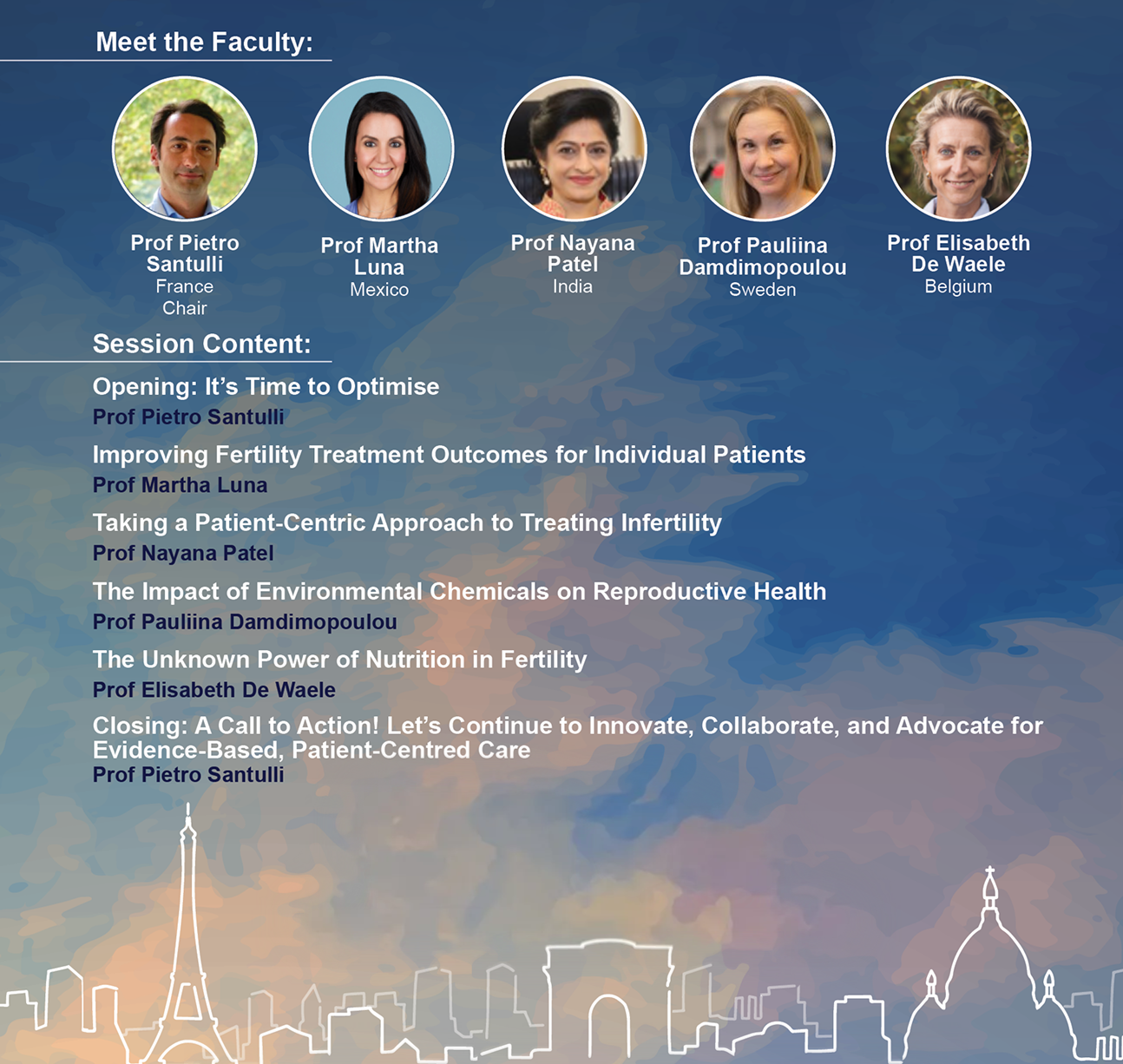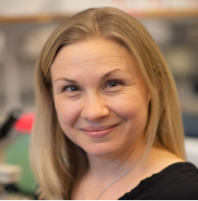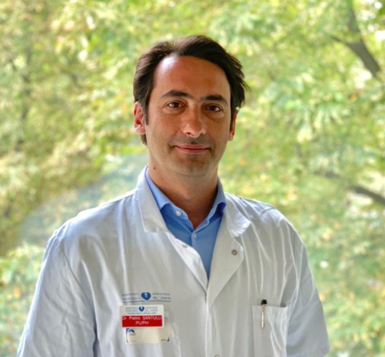Ferring Symposium: It’s Time to Optimize
During our ESHRE 2025 symposium we delved into the essential variables for optimising ART (assisted reproductive technologies) success with some esteemed experts.

Key Messages from our Symposium
1. Maximizing individual chance by OPTIMIZING treatment approaches
By harnessing the power of data driven science and precision medicine concept, we strive TO OPTIMIZE treatment outcomes for each individual patient. Our holistic approach considers cultural, geographical, and clinical factors to deliver tailored therapies.
2. Driving the RM ecosystem towards future directions
Our collaboration with leading research and clinical institutions ensures scientific excellence and empowers us to drive innovation in the field of RM by integrating clinical expertise, medical and environmental co-factors. By fostering a collaborative scientific community, we can break down silos and pool resources to tackle complex fertility challenges
It’s Time To Optimize
Don’t miss a minute of the Ferring Symposium during ESHRE 2025 in Paris. Watch the full symposium here!

Speakers and key takeaways
Prof. Martha Luna (Mexico)
Improving Fertility Treatment Outcomes for Individual Patients
- The global ART landscape is undergoing a profound transformation1-4
- While several clinical paradigms in ART are now well-established, others may never reach universal consensus5-8
- It’s time to move beyond personalisation and embrace truly personcentred fertility care
- Bringing together data, clinical intuition, and patient-centred values is the path toward smarter, more effective, and truly individualised fertility care
Prof. Nayana Patel (India)
Taking a Patient-Centric Approach to Treating Infertility
- Patient-centred care respects emotional, social, medical dimensions of infertility
- Regional investigations are required to fully address the challenges patients with infertility face
- The future of ART lies in balancing clinical excellence with patient empowerment
Prof. Pauliina Damdimopoulou (Sweden)
The Impact of Environmental Chemicals on Reproductive Health
- Most chemicals on the market are untested for safety. Chemical and plastics production are increasing.9
- Chemicals and plastic end up as contaminants in the environment. Everyone faces lifelong exposure to pollution that did not exist a century ago. 10-16
- Exposures correlate with reduced reproductive fitness in humans and animals. Focus has been on men, but women are also affected.10-16
- Lifestyle choices can reduce exposures. For example, by avoiding plastics, personal care products, canned food, processed food, coated cookware
Prof. De Waele (Belgium)
The Unknown Power of Nutrition in Fertility
- Body composition is more important than body weight17
- Body disbalance is associated with reproductive failure and pregnancy complications18,19
- Body disbalance negatively effects ART outcomes oocyte quality is affected20
- 3 months lifestyle intervention with nutritional therapy, psychological coaching and physical exercise has a positive impact on ART outcome21
Prof. Santulli (France)
Closing: A Call to Action! Let’s Continue to Innovate, Collaborate, and Advocate for Evidence-Based, Patient-Centred Care
- As ART clinical practice continues to advance, we must consider how multifactorial contributions affect fertility outcomes
- ART protocols need to be adapted to the unique nuances of each patient – this is the essence of person-centred medicine
- Patients of all ethnicities need to feel empowered in their fertility journey
- We need to work together and with patients to create a safer environment
- Biophysical parameters and nutrition must be considered in both partners looking to conceive
Key takeaway videos
Watch the interviews here:
Prof. Martha Luna (Mexico)
Prof. Pauliina Damdimopoulou (Sweden)
Prof. De Waele (Belgium)
Prof. Santulli (France)
New presented science from Ferring
Supporting cutting-edge science and bold research is vital in our mission to help build families and help people live better lives. At Ferring, we are proud to partner with healthcare professionals to help advance clinical practice and improve outcomes in reproductive medicine.
Helping build families and improve lives is central to Ferring’s mission, which is why we strongly support cutting-edge science and bold research. Year after year, we proudly partner with healthcare professionals on well-designed research to address clinical questions, advance clinical practice, and improve outcomes in reproductive medicine.
ADAPT-1: A multicentre, randomised, assessor-blind comparison of ovarian stimulation with follitropin delta versus follitropin alfa for in vitro fertilisation using conventional dosing regimens. (O-242)
Bernabeu A, Zajc P, Sanchez MG, Agrawal R, Papaleo E, Jirecek S, Møgelmose S, Jepsen I, Lobo R
Key takeaways
- Multi-centre, assessor-blind RCT (randomized control trail) in Europe comparing starting dose follitropin delta 15 µg/day vs. follitropin alfa 225 IU/day using conventional dosing
- Primary endpoint: Mean number of oocytes retrieved was identical (9.9) in both groups, confirming equivalent ovarian response
- Clinical pregnancy and implantation rates were comparable between groups (clinical pregnancy ~31%, implantation ~37–39%)
- Very low incidence of OHSS (ovarian hyperstimulation syndrome) and similar safety profiles between groups
- Findings support dose equivalence and reinforce the clinical value of follitropin delta in conventional regimens
Pregnancy and live birth rates in first blastocyst transfer: Fresh versus frozen – An individual patient data meta-analysis based on randomised controlled trials with follitropin delta. (O -247)
Moley K, Falahati A ,Engberg Jepsen I, Pingborg A, Santos-Ribeiro A, Macklon NS, Lobo R
Key takeaways
- Individual patient data meta-analysis on 4 randomised controlled follitropin delta trials
- Pregnancy and live birth rates (LBR) were compared between patients with fresh transfer (n=1303) vs frozen transfer (n=282)
- In low and normo-responders (AMH* <15 pmol/L and patients with 1-14 oocytes retrieved), LBR was similar with fresh and frozen transfer following follitropin delta treatment
- In high responders (AMH* ≥15 pmol/L and patients with ≥15 oocytes retrieved), LBR was significantly higher with frozen transfer following follitropin delta treatment
* Anti-Müllerian Hormone
The association between the number of blastocyst transfer cycles and cumulative live birth rate in ovarian stimulation. (P-650)
Falahati A, Moley K, Engberg Jepsen I, Santos-Ribeiro A, Pinborg A, Macklon NS, Lobo R
Key takeaways
- Individual patient data meta-analysis on 4 randomized controlled follitropin delta trials, with 1585 patients who underwent COS (controlled ovarian stimulation) with individualized follitropin delta
- Cumulative live birth rate (CLBR) increased significantly with each transfer cycle up to the 4th cycle
- CLBR increased with each transfer cycle regardless of age (increase observed in both women aged <35 and in women aged >35 years)
Cost-effectiveness of follitropin delta versus follitropin alfa for controlled ovarian stimulation for IVF/ICSI in China. (P-729)
Han S, Rui Y, Guan X, Carette JM, Markert M, Liu L, Qiao J
Key takeaways
- An economic model was used to estimate relative costs and effect of follitropin delta vs follitropin alfa for women undergoing IVF/ICSI in China
- The decision tree model reflects one COS (controlled ovarian stimulation) cycle with one fresh and up to three frozen transfers
- The analysis demonstrates that follitropin delta has a high probability of being a more effective and less costly treatment option in Chinese treatment practices
- As the number of frozen transfers increases (max. 3), the greater the cost saving
Association between endometrial thickness and live birth in fresh embryo transfer cycles: An individual patient data meta-analysis based on randomised controlled trials with follitropin delta. (P-458)
Lobo R, Falahati A, Moley K, Pinborg A, Santos-Ribeiro S, Macklon NS, Engberg Jepsen I
Key takeaways
- Individual patient data meta-analysis on 7 randomised controlled follitropin deltatrials
- Analysis included patients who underwent an embryo transfer in the fresh cycle after follitropin delta treatment (n=2207)
- Live birth rate plateaued at an endometrial thickness of >10 mm
- A thick endometrium (>14 mm) was not an impairment
- Endometrial thickness <7 mm was rare and resulted in an acceptable live birth rate
- There was no association between endometrial thickness and early pregnancy loss
Want to know more?
Would you like to request a follow-up with your Ferring representative? Please contact your Key Accountmanager at Ferring.
References:
1. GBD 2021 Fertility and Forecasting Collaborators. Lancet. 2024;403:2057–2099; 2. Zegers-Hochschild F et al. Reprod Biomed Online. 2025;50:104413; 3. Humphries LA et al. Am J Obstet Gynecol. 2016;214:212.e1-212.e17; 4. Setti AS et al. Reprod Biomed Online. 2022;44:370-379; 5. Bosch E et al. Front Endocrinol. 2020;11:67; 6. Cimadomo D. Front Endocrinol. 2018;9:327; 7. Gill P et al. Human Reproduction. 2024;39:974-980; 8. Ducreux B et al. Hum Reprod Update. 2024;30:26–47. 9. European Commission. Chemical Strategy for Sustainability Towards a Toxic-Free Environment. Brussels 2020; 10. Björvang RD et al. Environ Health 2020;19:67; 11. Björvang RD et al. Environ Int 2021;155:106589; 12. Björvang RD et al. Environ Res 2022;208:112626; 13. Bellavia A et al. Environ Res 2023;216:114447; 14. Björvang RD & Damdimopoulou P. Ups J Med Sci 2020;125:85-94; 15. Li X et al. Toxicology 2023;141:105410; 16. Panagiotou EM et al. Toxicology 2024;505:153815; 17. Darci E et al. Reprod Biomed Online 2025;104941; 18. Ramlau-Hansen CH. Human reproduction 2007;22:1634–1637; 19. George JS et al. Am J Obstet Gynecol 2024;230:239.e1-14; 20. Pinborg A et al. Reprod Biomed Online 2011;23:490-499; 21. Collin L et al. Master thesis VUB 2024. Courtesy of speaker. Unpublished data from FerMet @ Brussels IVF.
DE-RMMH-2500120







